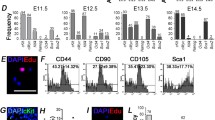Abstract
The objective of this study is to investigate the negative immunomodulatory capacity of human amniotic mesenchymal cells (AMSCs) and their possible intrinsic mechanism, by which we can confirm that they modulate microglial activation of central nervous system from multiple perspectives at the molecular level. The identification of the immune phenotype of AMSCs and microglial cells was executed by immunohistochemical methods and flow cytometry. Meanwhile, the influence and mechanism of amniotic mesenchymal cells in vitro on proliferation, cell cycle, and cytokine release of activated microglia (MI) would be detected by ELISA, β-liquid scintillation counting method, and flow cytometry. Human amnion mesenchymal cells highly expressed negative co-stimulatory molecules PD-L1, while its ligand PD1 was expressed with high level by activated MI. When adding the PD-L1mAb to the mixed culture system composed of AMSCs and activated MI, the proliferation inhibitory effect and the cycle-blocking effect produced by the former on the latter would be partially reversed; at the same time, the impact of the latter cytokine secretion would be adjusted. As a conclusion, AMSCs play inhibitory effects on microglial activation, proliferation, and immune effects partially through the PD-L1–PD1 signaling pathways.












Similar content being viewed by others
References
Aldinucci, A., Rizzetto, L., Pieri, L., et al. (2010). Inhibition of immune synapse by altered dendritic cell actin distribution: A new pathway of mesenchymal stem cell immune regulation. The Journal of Immunology, 185(9), 5102–5110.
Choi, Y. S., Jeong, J. A., & Lim, D. S. (2012). Mesenchymal stem cell-mediated immature dendritic cells induce regulatory T cell-based immunosuppressive effect. Immunological Investigations, 41(2), 214–229.
Dheen, S. T., Kaur, C., & Ling, E. A. (2007). Microglial activation and its implications in the brain diseases. Current Medicinal Chemistry, 14, 1189–1197.
Gebler, A., Zabel, O., & Seliger, B. (2012). The immunomodulatory capacity of mesenchymal stem cells. Trends in Molecular Medicine, 18(2), 128–134.
Iravani, M. M., Leung, C. C., Sadeghian, M., et al. (2005). The acute and the long-term effects of nigral lipopolysaccharide administration on dopaminergic dysfunction and glial cell activation. European Journal of Neuroscience, 22(2), 317–330.
Jurewicz, M., Yang, S., Augello, A., et al. (2010). Congenic mesenchymal stem cell therapy reverses hyperglycemia in experimental type 1 diabetes. Diabetes, 59(12), 3139–3147.
Kaplan, J. M., Youd, M. E., Lodie, T. A., et al. (2011). Immunomodulatory activity of mesenchymal stem cells. Current Stem Cell Research and Therapy, 6(4), 297–316.
Krampera, M., Sartoris, S., Liotta, F., et al. (2007). Immune regulation by mesenchymal stem cells derived from adult spleen and thymus. Stem Cells and Development, 16(5), 797–810.
Kronsteiner, B., Wolbank, S., Peterbauer, A., et al. (2011). Human mesenchymal stem cells from adipose tissue and amnion influence T-cells depending on stimulation method and presence of other immune cells. Stem Cells and Development, 20(12), 2115–2126.
Larsen, S., & Lewis, I. D. (2011). Potential therapeutic applications of mesenchymal stromal cells. Pathology, 43(6), 592–604.
Lassmann, H. (2008). Mechanisms of inflammation induced tissue injury in multiple sclerosis. Journal of the Neurological Sciences, 274, 45–47.
Li, H., Guo, Z., Zhu, H., et al. (2010). Transplanted mesenchymal stem cells can inhibit the three developmental stages of murine acute graft-versus-host disease. In Vivo, 24(5), 659–666.
Merson, T. D., Binder, M. D., & Kilpatrick, T. J. (2010). Role of cytokines as mediators and regulators of microglial activity in inflammatory demyelination of the CNS. Neuromolecular Medicine, 12(2), 99–132.
Ning, H. M., Jin, J. G., Hu, J. W., et al. (2005). Effect of human bone marrow mesenchymal stem cell on allogeneic T lymphocyte phenotype in vitro. Zhongguo Shi Yan Xue Ye Xue Za Zhi, 13(1), 43–49.
Ransohoff, R. M., & Perry, V. H. (2009). Microglial physiology: Unique stimuli, specialized responses. Annual Review of Immunology, 27, 119–145.
Rodríguez, R., García-Castro, J., Trigueros, C., et al. (2012). Multipotent mesenchymal stromal cells: Clinical applications and cancer modeling. Advances in Experimental Medicine and Biology, 741, 187–205.
Saijo, K., & Glass, C. K. (2011). Microglial cell origin and phenotypes in health and disease. Nature Reviews Immunology, 11(11), 775–787.
Schmitz, T., & Chew, L. J. (2008). Cytokines and myelination in the central nervous system. The Scientific World Journal, 8, 1119–1147.
Sioud, M., Mobergslien, A., Boudabous, A., et al. (2011). Mesenchymal stem cell-mediated T cell suppression occurs through secreted galectins. International Journal of Oncology, 38(2), 385–390.
Stagg, J. (2007). Immune regulation by mesenchymal stem cells: Two sides to the coin. Tissue Antigens, 69(1), 1–9.
Stalder, A. K., Carson, M. J., Pagenstecher, A., et al. (1998). Late-onset chronic inflammatory encephalopathy in immune-competent and severe combined immune-deficient (SCID) mice with astrocyte-targeted expression of tumor necrosis factor. American Journal of Pathology, 153(3), 767–783.
Wong, A., Dukic-Stefanovic, S., Gasic-Milenkovic, J., et al. (2001). Anti-inflammatory antioxidants attenuate the expression of inducible nitric oxide synthase mediated by advanced glycation end products in murine MI. European Journal of Neuroscience, 14(12), 1961–1967.
Author information
Authors and Affiliations
Corresponding author
Rights and permissions
About this article
Cite this article
Wu, W., Lan, Q., Lu, H. et al. Human Amnion Mesenchymal Cells Negative Co-stimulatory Molecules PD-L1 Expression and Its Capacity of Modulating Microglial Activation of CNS. Cell Biochem Biophys 69, 35–45 (2014). https://doi.org/10.1007/s12013-013-9763-9
Published:
Issue Date:
DOI: https://doi.org/10.1007/s12013-013-9763-9




